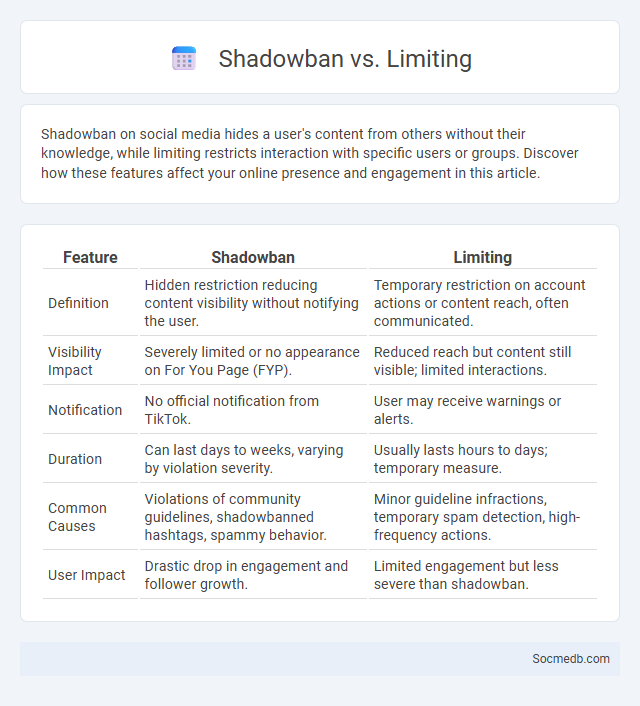
Photo illustration: Shadowban vs Limiting
Shadowban on social media hides a user's content from others without their knowledge, while limiting restricts interaction with specific users or groups. Discover how these features affect your online presence and engagement in this article.
Table of Comparison
| Feature | Shadowban | Limiting |
|---|---|---|
| Definition | Hidden restriction reducing content visibility without notifying the user. | Temporary restriction on account actions or content reach, often communicated. |
| Visibility Impact | Severely limited or no appearance on For You Page (FYP). | Reduced reach but content still visible; limited interactions. |
| Notification | No official notification from TikTok. | User may receive warnings or alerts. |
| Duration | Can last days to weeks, varying by violation severity. | Usually lasts hours to days; temporary measure. |
| Common Causes | Violations of community guidelines, shadowbanned hashtags, spammy behavior. | Minor guideline infractions, temporary spam detection, high-frequency actions. |
| User Impact | Drastic drop in engagement and follower growth. | Limited engagement but less severe than shadowban. |
Understanding the Concept: What Is a Shadowban?
A shadowban on social media refers to the covert restriction of your account's visibility without explicit notification, causing your posts to become hidden or less prominent in feeds and search results. Platforms like Instagram and Twitter use shadowbanning to limit content that violates community guidelines or appears spammy, impacting your engagement metrics significantly. Understanding this concept helps you recognize sudden drops in reach and adjust your content strategy to avoid punitive algorithms.
Defining Limiting: Restricting User Reach
Limiting on social media involves restricting user reach by controlling the visibility of posts, often through algorithms that prioritize specific content types or user interactions. Your content's exposure is curtailed when platforms reduce distribution based on engagement metrics, user behavior, or compliance with community guidelines. This restriction impacts audience growth, engagement rates, and overall digital presence.
Shadowbanning Explained: Modern Internet Moderation
Shadowbanning refers to an internet moderation technique where a user's content is hidden or less visible without their knowledge, affecting visibility on platforms like Instagram, Twitter, and TikTok. This approach aims to reduce spam or harmful content by limiting reach without alerting the user, which can impact Your engagement and online presence. Understanding how algorithms detect policy violations can help you navigate and adapt to these restrictions more effectively.
Key Differences: Shadowban vs Limiting
Shadowban on social media restricts content visibility without user notification, making posts unseen by followers or in search results, while limiting usually curtails interactive features like comments or messaging to reduce user exposure. Shadowbanning often targets entire profiles or specific content for violating platform policies, whereas limiting is a softer approach focusing on managing user interactions without full content suppression. Understanding these key differences helps users and marketers adjust strategies for content reach and engagement within platform ecosystems.
How Platforms Implement Shadowbanning
Social media platforms implement shadowbanning by using algorithms that detect and limit the visibility of content violating community guidelines without notifying the user. This covert moderation technique restricts your reach, reducing engagement by hiding posts from search results and follower feeds. Platforms leverage machine learning models and keyword filters to identify problematic behavior and subtly suppress accounts deemed as spammy, abusive, or harmful.
Detection: Signs You’ve Been Shadowbanned or Limited
Shadowbanning on social media can severely limit your content's visibility without your knowledge, impacting engagement and follower growth. Signs you've been shadowbanned include drastic drops in impressions, reduced interactions on posts, and your content not appearing on hashtag searches or follower feeds. You should regularly monitor analytics and test your content reach to detect limitations imposed by algorithm restrictions or platform policies.
Impact on User Engagement and Visibility
Social media platforms significantly enhance user engagement by enabling real-time interaction, personalized content, and targeted advertising, which increases visibility for brands and individuals alike. Your content's reach improves through algorithm-driven feeds that prioritize relevant and engaging posts, boosting the likelihood of shares, comments, and likes. These dynamic features foster a loyal online community and drive higher traffic, ultimately amplifying your digital presence.
Platform-Specific Policies: Instagram, Twitter, TikTok
Instagram enforces strict community guidelines prohibiting hate speech, misinformation, and explicit content, utilizing AI to detect violations and maintain user safety. Twitter prioritizes transparency and limits misinformation through its labeling system and policies addressing harassment, while allowing real-time public discourse with minimal content removal. TikTok emphasizes content moderation tailored to its younger audience, restricting harmful challenges and misinformation, and employs algorithmic reviews alongside human moderators to enforce platform-specific standards.
User Strategies to Avoid Shadowban and Limiting
To avoid shadowban and limiting on social media, you should consistently engage with authentic content and avoid automated behaviors like excessive posting or repetitive comments. Prioritize genuine interactions by responding thoughtfully to followers and diversifying your content types, including images, videos, and stories. Monitoring platform guidelines regularly helps ensure your strategies align with the latest algorithms, maintaining your visibility and reach.
The Future of Content Moderation: Transparency and Ethics
Content moderation in social media will increasingly prioritize transparency and ethics to build user trust and ensure fair platform governance. Advanced AI tools will support moderators by detecting harmful content more accurately while maintaining user privacy and minimizing censorship biases. Your engagement with platforms embracing ethical moderation practices ensures a safer, more accountable online environment.
 socmedb.com
socmedb.com